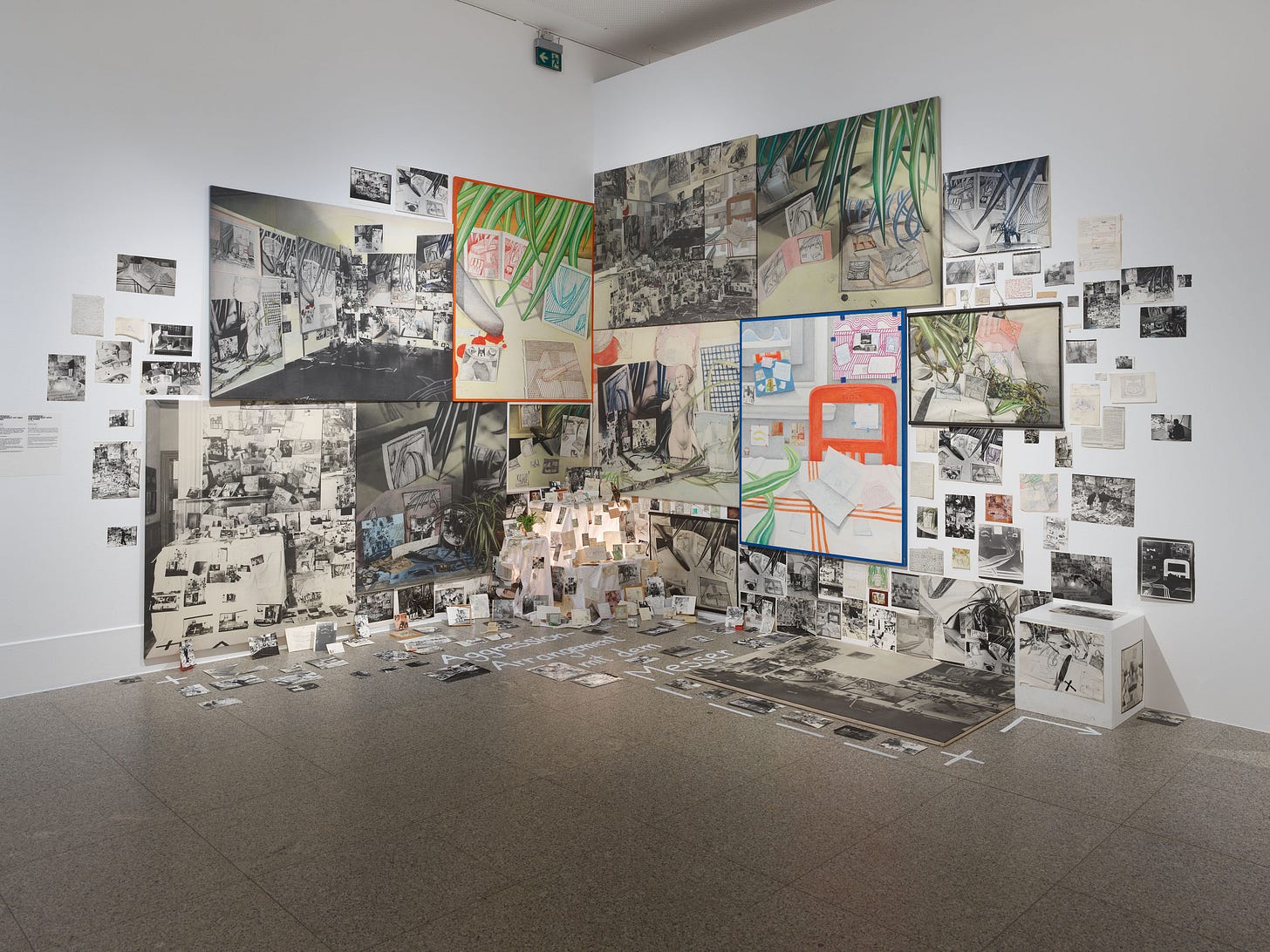Anna Oppermann's Overwhelmingly Structured Chaos
30 years after her death, the Bundeskunsthalle Bonn dedicates an all-encompassing exhibition to an artist who never shied away from difficult questions.
Some Madness & Badness: Combinyashun
Complexity has to play a role somewhere in this world. It is impossible to tackle a problem without taking into account that every problem is connected to other problems. - Anna Oppermann in conversation with Margarethe Jochimsen, 1984
Anna (1940–1993, German) is the art history version of that Pepe Silvia meme from It’s Always Sunny in Philadelphia. She connects the threads between power relations, perception, the art market, the economy, relationships, the compatibility of being an artist and having a family, womanhood, elitist education, and so much more.

To illustrate connections, Anna created her so-called ensembles. Some modestly fill a corner, others plaster the walls of an entire room up to the ceiling. It’s impossible to recreate Anna’s ensembles one-to-one, she knew and allowed space for interpretation. The curators rebuilt her ensembles as a so-called Interpretive New Installation.
These combinations of pedestals, sketches, plants (Idk why but there’s a lot of chives), drawings, pictures, small sculptures (I even spotted a cookie in between), photos, photo canvases, and texts with tape on the floor recall crime scenes. Forensic investigation skills are quite helpful in dissecting these thematic rabbit holes. Some secrets are never to be revealed, though, like the identity of a mysterious Mr. S. frequently popping up in her ensembles. There's also something spiritual to the candles and the overload of pictures. Like a street altar or a commemorative wall.
The exhibition builds anticipation, starting with the smaller ensembles and leading up to her room-filling blockbusters. Most images used in these ensembles are black and white. Sometimes, color jumps out in a detail as if a real-world object got stuck in a film noir. Anna blurs the line between photograph, painting, and drawing, especially with her photo canvases combining snapshots and drawings into one. Pictures reappear inside other pictures like infinite matryoshka dolls or 17th-century paintings of aristocratic picture galleries. Anna often uses specific colors by themes. Red for ensembles on love and sexuality, blue for one about lies (based on the German saying Das Blaue vom Himmel herunterlügen).

Mediating communication
Images and texts are smaller or larger according to importance. Long paragraphs explain concepts and correlations. It’s easy to get lost in their sheer overabundance. Anna invites viewers to have a look, but she doesn’t expect anyone to study every single detail: “If you want to, it’s enough to have a look at a few pictures and the bigger headlines. God, wouldn’t it be awful having to read everything?”, she recalled in an old interview.
Even though it feels overwhelming to look at her work, Anna is genuinely interested in the relationship between the viewer and the artist. There’s a fun series of drawings called Being An Artist - On the Method (Drawing In the Ensemble, Dilemma of Communication, the Economic Aspect) (1978-1985). These drawings work like essays or diagrams investigating the tensions between making art and understanding it. When communication is lacking, the polite and understanding viewer turns into a vengeful armed Hitler-lookalike (?) ready to label everything coming his way as BS.

Distorted POVs
The exhibition introduced Anna selecting some of her darker work with cunty grunge-supermodel photographic self-portraits (she lowkey ate) and some creepy Robert Rauschenberg (1925-2008, American) coded canvases. Her bright drawings in the next room therefore came as a shock. These mostly large-scale ‘60s and ‘70s crayola drawings composed of rounded wavy strokes are surprisingly cartoonish and cheeky compared to the emo energy dominating the first room.

Anna used dizzying perspectives long before it was trendy. As the viewer, I take on her POV awkwardly looking down her legs. She’d often place a small round mirror on her lap, her pelvis (also a recurring form in many works) framing whatever the mirror reflected. Infinite reflections seem to rip apart any logical space-time, opening portals into uncountable realities. She often contorts space into impossible forms, making bodies panoramic and visible from several angles at once. Anna walked so Jana Euler (Millenial, German) could run.
To Anna, reality was never flat, linear, or one-dimensional. It’s complicated, confusing, and conflicting. Approaching a problem from various angles at once, she practiced intersectionality long before it became scholarly common practice. She was unafraid to take up space. She defied expectations of easy-to-sell, easy-to-exhibit, and easy-to-understand art, she named one ensemble in particular MSSVO - “Make Small, Straightforward, Vendible Objects!” (1979-1992). I spotted a paper scrap on one photo canvas that sums it up best. It said No space for easy answers.
Connect the dots at Anna Oppermann: A Retrospective until April 1, 2024, at Bundeskunsthalle Bonn.
Bundeskunsthalle Bonn
Helmut-Kohl-Allee 4
53113 Bonn
Website
Instagram: @bundeskunsthalle
I wanna know if they took a new cookie for the exhibition or whether they conserved the original one. This will keep me up at night… Anyway you know the drill: Like, comment, share. Thank you!!
See you soon!!!
Jennifer
The Gen Z Art Critic




